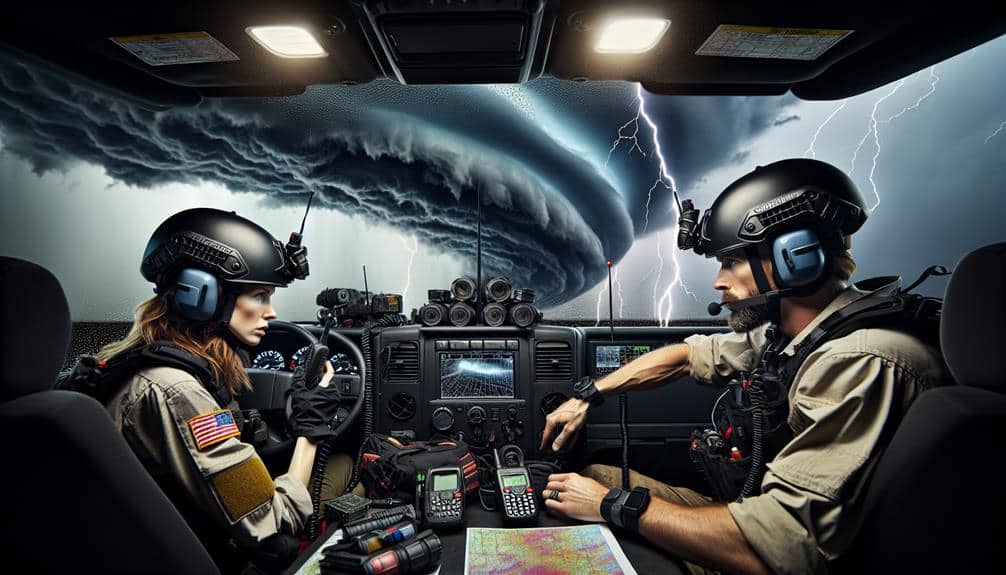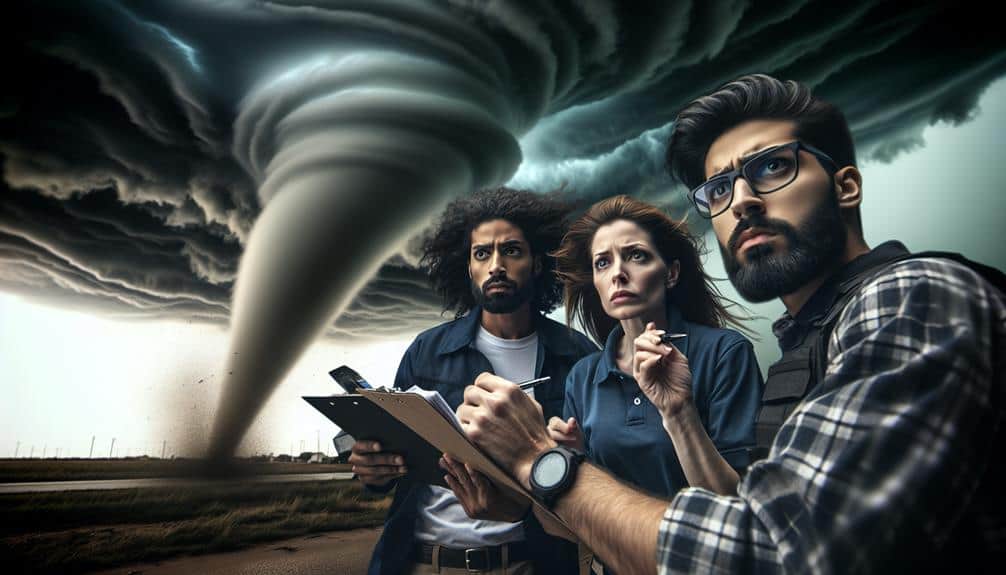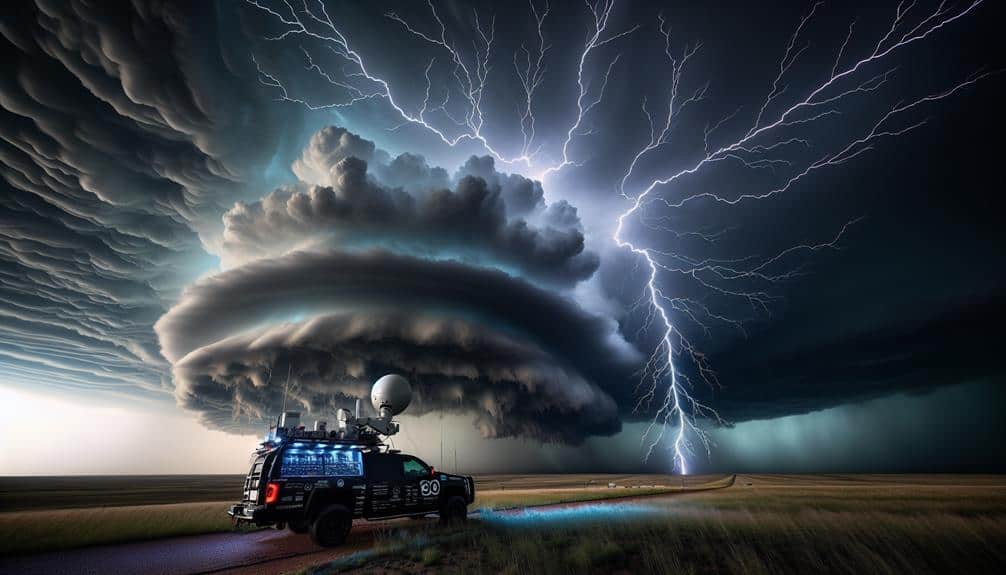As experienced storm chasers, as experts in the field, adhering to strict safety practices is crucial. We depend on precise meteorological tools, state-of-the-art weather monitoring systems, and up-to-the-minute data from mobile applications. Using top-notch gear and well-kept vehicles, we make sure our equipment is reliable. We maintain safe distances by staying at least one mile away from the storm's core and positioning for excellent visibility. Having an emergency plan with practice drills and necessary supplies is vital. We also communicate our routes and updates to local authorities using dependable devices. These practices facilitate safer and more knowledgeable storm chasing.
Key Points
- Regularly monitor real-time weather data using tools like Doppler radar and satellite imagery.
- Equip your vehicle with high-quality gear and perform regular maintenance checks.
- Maintain a safe distance of at least one mile from the storm's core.
- Have a well-practiced emergency plan and a checklist of essential supplies.
Monitor Weather Conditions
To ensure safety while storm chasing, we must continuously monitor weather conditions using reliable meteorological tools and real-time data. This approach helps us make informed decisions and implement effective safety precautions.
Utilizing advanced weather monitoring systems, such as Doppler radar and satellite imagery, provides us with accurate and up-to-date information on storm movements, intensity, and potential hazards.
Staying connected to real-time data streams is essential. Mobile applications and dedicated storm chasing software allow us to track weather patterns and receive timely alerts. By analyzing atmospheric conditions, we can predict storm behavior and adjust our routes accordingly. This minimizes the risk of encountering severe weather unexpectedly.
Effective weather monitoring also involves understanding meteorological concepts. Familiarity with terms like supercells, updrafts, and downdrafts helps us interpret data accurately. Additionally, we should frequently consult the National Weather Service and other reputable sources for updates and advisories.
Use Reliable Equipment
Equipping ourselves with dependable and high-quality gear is crucial for guaranteeing both our safety and the success of our storm chasing endeavors.
First, our primary tool, the vehicle, must be sturdy and well-maintained. Regular equipment maintenance, such as checking tire tread, brakes, and engine performance, is non-negotiable. We can't afford mechanical failures when we're tracking severe weather.
Moreover, our data collection devices—radars, anemometers, and cameras—must be trusted brands known for durability. Keeping them calibrated and in peak condition ensures the accuracy of the information we gather. Each piece of equipment should have backup power sources, like additional batteries or portable generators, to prevent any interruptions.
Emergency supplies are another crucial aspect. It's essential to carry a well-stocked first aid kit, non-perishable food, water, and blankets. Communication devices like satellite phones and two-way radios guarantee we stay connected even in areas with poor cell reception.
Let's not overlook personal protective gear: helmets, sturdy boots, and weather-resistant clothing. These items shield us from the elements and potential debris. By investing in and maintaining dependable equipment, we enhance both our safety and our ability to capture valuable storm data.
Maintain Safe Distances
While dependable equipment is crucial, maintaining safe distances from storms is equally vital to secure our well-being. By securing safe positioning, we reduce the risk of encountering life-threatening situations. We need to keep a significant buffer zone between us and the storm to avoid sudden shifts in weather patterns that could trap us. A good rule of thumb is to stay at least one mile away from the core of the storm to guarantee we've enough reaction time if conditions worsen.
Proper visibility is another critical factor in storm chasing. We need to position ourselves where we've a clear, unobstructed view of the storm's development. This not only aids in data collection but also secures we can see potential hazards, like flying debris or flash floods, well in advance. High ground or open fields are preferable for maintaining visual contact while keeping a safe distance.
Have an Emergency Plan
Having an emergency plan is essential for safeguarding our safety during unpredictable and volatile storm conditions. When we're out chasing storms, we need to be prepared for any situation that might arise. A well-organized emergency plan will help us stay focused and react quickly when the unexpected happens.
Here are three key components to incorporate into our emergency plan:
- Practice drills: Regularly conduct practice drills to guarantee everyone knows their role and can act swiftly under stress. These drills should cover various scenarios, such as vehicle breakdowns, sudden changes in storm direction, and rapid evacuation procedures.
- Designated meeting spot: Establish a designated meeting spot where the team can regroup if separated. This location should be easily identifiable and accessible, even in poor weather conditions. Knowing exactly where to go reduces confusion and saves valuable time during an emergency.
- Supply checklist: Maintain a checklist of essential supplies, including first aid kits, flashlights, extra batteries, and communication devices. Ensure these items are always up-to-date and easily accessible.
Communicate With Authorities

Effective communication with local authorities is important for securing our safety and obtaining real-time updates during storm chasing. By maintaining open lines of communication, we can align ourselves with emergency protocols and receive vital information that could impact our immediate decisions.
First, before heading out, we should inform local emergency management offices about our planned routes and estimated timelines. This proactive step ensures that authorities are aware of our presence and can assist if necessary. Additionally, carrying reliable communication devices such as two-way radios or satellite phones ensures we remain in contact even in remote areas where cellular networks may fail.
During the chase, it's essential to monitor emergency broadcasts and weather updates continuously. This allows us to adapt our strategies based on the latest data. We should also engage in reporting findings to local authorities. Sharing real-time observations about storm developments can be valuable for community safety and emergency response planning.
Frequently Asked Questions
What Should I Wear While Storm Chasing?
For the Current Question, our clothing choices should include durable, weather-resistant outerwear and layers for temperature regulation. We must also use safety gear like helmets, sturdy boots, and gloves to guarantee protection during storm chasing.
How Can I Identify Safe Parking Spots During a Chase?
A stitch in time saves nine. We should prioritize parking strategies by identifying safe locations, such as elevated areas away from flood zones and avoiding underpasses. Always face the vehicle toward an exit for a quick getaway.
What Are the Best Apps for Real-Time Storm Tracking?
For the Current Question, we recommend top radar apps like RadarScope and Storm Shield. They provide real-time tracking and emergency alerts, ensuring we stay informed and safe while chasing, giving us the freedom to explore with confidence.
How Do I Avoid Road Hazards in Severe Weather?
To avoid road hazards in severe weather, we should maintain defensive driving techniques and guarantee our emergency communication systems are functional. Stay vigilant, reduce speed, and keep a safe distance from other vehicles. Safety first guarantees our freedom.
What Are Some Tips for Driving in Heavy Rain and Wind?
When driving in heavy rain and wind, we should reduce speed to improve windshield visibility and control. If handling hydroplaning, we must gently steer and avoid sudden braking to regain traction and maintain vehicle stability.


